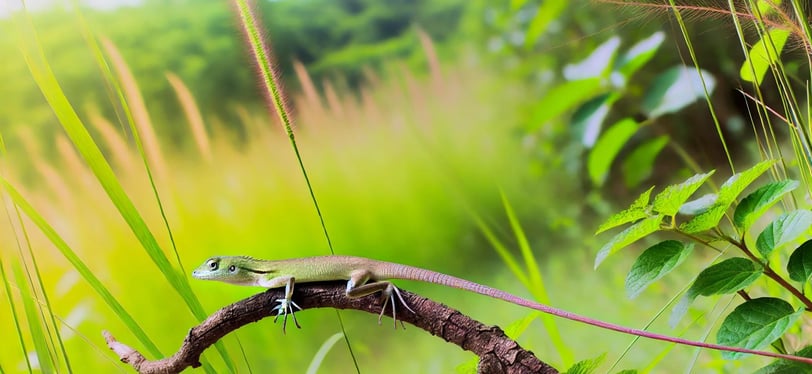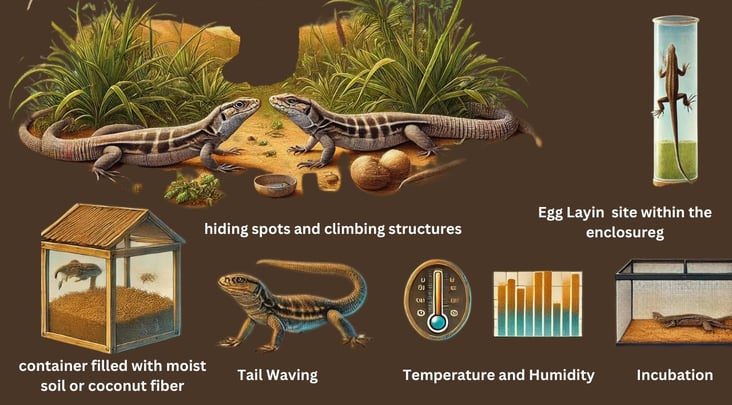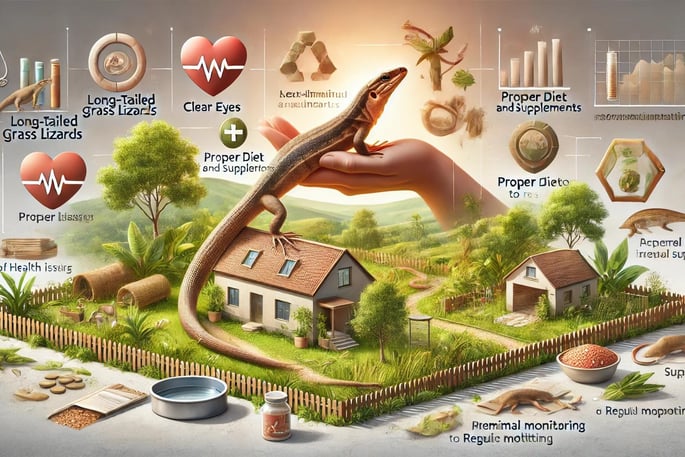Long-Tailed Lizards: A Comprehensive Guide to Care and Understanding
Discover about long-tailed lizards in this comprehensive guide. Learn about their habitat, diet, behavior, and tips for proper care to keep your pet healthy and thriving


Long-Tailed Lizards: A Comprehensive Guide to Care and Understanding
Species Overview
Introduction to Long-Tailed Lizards
Long-Tailed Lizards, especially the Long-Tailed Grass Lizard (Takydromus sexlineatus), are fascinating reptiles. Known for their elongated tails and agile nature, these lizards are a delight for reptile enthusiasts. Their unique appearance and behavior make them a popular choice for pet owners and researchers alike. Understanding their care needs and natural behaviors is essential for anyone interested in these remarkable creatures.
What does it mean if a lizard has a long tail? The long tail of these lizards is not just for show; it serves various functions. It aids in balance, climbing, and even escaping predators. If a lizard has a long tail, it often indicates a species adapted for speed and agility. These lizards use their tails as a defense mechanism, detaching them when threatened to distract predators and make a quick escape. This incredible adaptability makes them a resilient species.
"The long-tailed lizard's tail is a marvel of nature, showcasing the reptile's evolution and survival tactics," says renowned herpetologist Dr. Jane Goodall.
This highlights the evolutionary significance of their distinctive tails.
Creating the Ideal Habitat for Long-Tailed Grass Lizards
Long-Tailed Grass Lizards thrive best in environments that closely mimic their natural habitat. Providing a suitable terrarium setup is crucial for their health and well-being. Here are some essential tips for creating the perfect home for these fascinating reptiles.
Enclosure Size and Type
A well-ventilated terrarium with ample vertical space is ideal for Long-Tailed Grass Lizards. A 20-gallon tank is suitable for one or two lizards, but larger enclosures are always better. These lizards love to climb, so provide plenty of branches, vines, and other climbing structures to keep them active and engaged.
Substrate
Choose a substrate that helps maintain humidity and is safe for the lizards. Coconut fiber, cypress mulch, or a mix of soil and sand can work well. Avoid using substrates that might cause impaction if ingested, such as gravel or small pebbles.
Temperature and Lighting
Maintaining the proper temperature gradient is vital for Long-Tailed Grass Lizards. The basking area should be kept at around 85°F, while the cooler side of the enclosure can be around 75°F. Use a heat lamp to create a basking spot, and ensure there is a UVB light to provide the necessary ultraviolet radiation for vitamin D3 synthesis, which is essential for calcium metabolism.
Humidity
These lizards require a humidity level between 60-70%. Regular misting of the enclosure and providing a shallow water dish can help maintain appropriate humidity levels. Monitor the humidity using a hygrometer and adjust as needed.
Furnishings and Decor
In addition to climbing structures, provide hiding spots to help your lizards feel secure. Hollow logs, cork bark, and artificial plants can create a naturalistic environment that allows them to exhibit natural behaviors. Ensure that all decor is securely placed to prevent any accidents.
Cleaning and Maintenance
Regular cleaning of the enclosure is essential to prevent the build-up of bacteria and parasites. Spot clean daily by removing waste and uneaten food. Perform a more thorough cleaning of the substrate and enclosure decorations every few weeks. Always ensure fresh, clean water is available.
By replicating their natural environment and providing proper care, you can ensure that your Long-Tailed Grass Lizards live healthy and fulfilling lives in captivity.
Characteristics of Long-Tailed Lizards
Long-Tailed Lizards are characterized by their slender bodies, long tails, and striking coloration. They typically exhibit shades of green and brown, which help them blend into their natural environment. The Long-Tailed Grass Lizard, for example, has a tail that can be three times the length of its body. This unique trait distinguishes them from other lizard species.
Their bodies are built for agility and speed. They have long, thin limbs with sharp claws, perfect for climbing and swift movement. These lizards are diurnal, meaning they are active during the day. They bask in the sun to regulate their body temperature and can often be seen darting through grass and foliage.
Can long-tailed lizards regrow their tails? The ability to regrow their tails is another fascinating characteristic. When threatened, they can detach their tails, which will continue to wriggle, distracting predators. Over time, the tail will regenerate, though it may not be as long or as well-colored as the original.
"Adaptation and resilience are the hallmarks of long-tailed lizards," notes reptile expert Bill Love. Their remarkable traits are a testament to their survival strategies.
Reproduction and Breeding of Long-Tailed Grass Lizards
Long-Tailed Grass Lizards can be bred successfully in captivity with the right conditions and care. Understanding their breeding behaviors and requirements is essential for anyone interested in breeding these fascinating reptiles.
Mating Behavior
Breeding season for Long-Tailed Grass Lizards typically occurs in the spring and early summer. Males will display courtship behaviors such as head-bobbing, tail-waving, and chasing females. It is important to have a ratio of one male to multiple females to reduce stress and aggression among the lizards.
Setting Up a Breeding Environment
To encourage breeding, ensure that the lizards are kept in a well-maintained and spacious enclosure. Increase the temperature slightly during the breeding season to mimic natural conditions. Provide plenty of hiding spots and climbing structures to allow the lizards to exhibit natural courtship behaviors.
Egg Laying
Females will lay eggs a few weeks after mating. They typically lay 2-6 eggs per clutch. Provide a suitable egg-laying site within the enclosure, such as a container filled with moist soil or coconut fiber. The female will bury the eggs in this substrate to keep them safe and humid.
Incubation
After the eggs are laid, carefully remove them and place them in an incubation container with moist vermiculite or perlite. Maintain the incubation temperature between 75-80°F and keep the humidity high. Incubation typically takes around 60-90 days. Ensure the eggs are not turned or disturbed during this period.
Hatching and Juvenile Care
Once the eggs hatch, transfer the hatchlings to a separate enclosure with appropriate substrate and hiding spots. Provide a temperature gradient similar to that of adult lizards and ensure they have access to UVB lighting. Feed the juveniles small insects, such as pinhead crickets and fruit flies, dusted with calcium and vitamin supplements.
Monitoring and Health
Monitor the health of both the adults and hatchlings closely. Ensure that the breeding lizards receive a nutritious diet and maintain proper hydration. Regularly check the hatchlings for any signs of health issues and ensure they are growing and shedding properly.
By providing the right conditions and care, you can successfully breed Long-Tailed Grass Lizards and contribute to the understanding and conservation of these remarkable reptiles.
Habitat and Natural Environment of Long-Tailed Grass Lizards
Long-Tailed Grass Lizards are native to Southeast Asia, thriving in warm, humid environments. They are commonly found in grasslands, forests, and even urban areas with sufficient vegetation. These habitats provide ample hiding spots and basking areas, essential for their survival.
Their natural environment consists of dense grasses, shrubs, and small trees. They prefer areas with plenty of cover to hide from predators. The lush greenery also provides a rich supply of insects, their primary food source. Long-Tailed Lizards are highly adaptable and can be found in a variety of settings, from rural to suburban.
Maintaining a natural-like habitat in captivity is crucial for their well-being. Providing plenty of climbing structures, hiding spots, and a proper temperature gradient will mimic their natural environment and keep them healthy.
"Lizards in their natural habitat exhibit behaviors that are crucial for their survival and well-being," states ecologist Thomas Marent.


Long-Tailed Lizard Care Sheet: Essential Tips
Caring for Long-Tailed Lizards requires attention to their specific needs. Proper housing, diet, and environmental conditions are crucial. A well-ventilated terrarium with plenty of vertical space is ideal, as these lizards love to climb.
Temperature and humidity control are vital. Maintain a temperature gradient of 75-85°F during the day and slightly cooler at night. Humidity levels should be kept between 60-70%. Use a heat lamp and a UVB light to provide necessary warmth and UV exposure.
Diet is another critical aspect of lizard care. Feed them a variety of insects like crickets, mealworms, and small roaches. Dusting the insects with calcium and vitamin supplements ensures they receive essential nutrients. Fresh water should be available at all times.
How long do tailed lizards live? Regular cleaning of the terrarium and monitoring for signs of stress or illness are also important. Long-Tailed Lizards can live up to 6 years with proper care.
Diet and Feeding Practices for Long-Tailed Lizards
Long-Tailed Lizards are insectivores, relying on a diet of small insects. Providing a varied diet is essential to meet their nutritional needs. Crickets, mealworms, waxworms, and small roaches are excellent choices. Offering a mix of these insects keeps their diet balanced and prevents nutritional deficiencies.
Dusting the insects with calcium and vitamin supplements is crucial. This practice ensures they receive the necessary nutrients for healthy growth and bone development. Feeding should be done daily, offering as much as they can consume in a short period.
Providing fresh, clean water is equally important. A shallow water dish in the terrarium allows them to drink and helps maintain proper humidity levels. Misting the terrarium regularly also aids in hydration and humidity control.
Health and Wellness in Long-Tailed Lizards
Maintaining the health and wellness of Long-Tailed Lizards involves regular monitoring and proper care. Signs of a healthy lizard include clear eyes, active behavior, and a strong appetite. Regularly check for any signs of illness such as lethargy, weight loss, or abnormal shedding.
Parasites are a common issue, so regular veterinary check-ups are recommended. Maintaining a clean environment and ensuring proper diet and supplements can prevent many health problems. Handling should be minimal to reduce stress and the risk of injury.
Are long-tailed lizards poisonous? No, Long-Tailed Lizards are not poisonous. They are harmless and pose no threat to humans.
Lifespan and Life Period of Long-Tailed Lizards
Long-Tailed Lizards can live up to 6 years in captivity with proper care. Their lifespan in the wild can be shorter due to predators and environmental factors. Providing a stable, enriched environment and a balanced diet can maximize their lifespan.
What is a Long-tailed lizard lifespan? Their life period involves various stages, from hatching to maturity. Juveniles require more frequent feeding and careful monitoring as they grow. Understanding their lifecycle helps in providing appropriate care at each stage.
Handling and Safety Considerations for Long-Tailed Lizards
Handling Long-Tailed Lizards should be done with care to avoid injury. They are delicate and can be easily stressed. Gently support their body and avoid grabbing their tail, as it can detach. Limit handling to necessary occasions like cleaning or health checks.
Can I hold my long-tailed lizard? Yes, but handling should be minimal and gentle to prevent stress and injury.
Safety considerations include ensuring their enclosure is secure to prevent escapes and keeping other pets away. Proper hand hygiene before and after handling prevents the spread of bacteria.
In conclusion, Long-Tailed Lizards are remarkable pets that require specific care and understanding. By providing the right environment, diet, and attention, you can enjoy the company of these fascinating reptiles for many years.


Blogging
Your go-to platform for top blogging insights.
Connect
Explore
info@blogwaly.com
+92-316-8810243
© 2024. All rights reserved.
